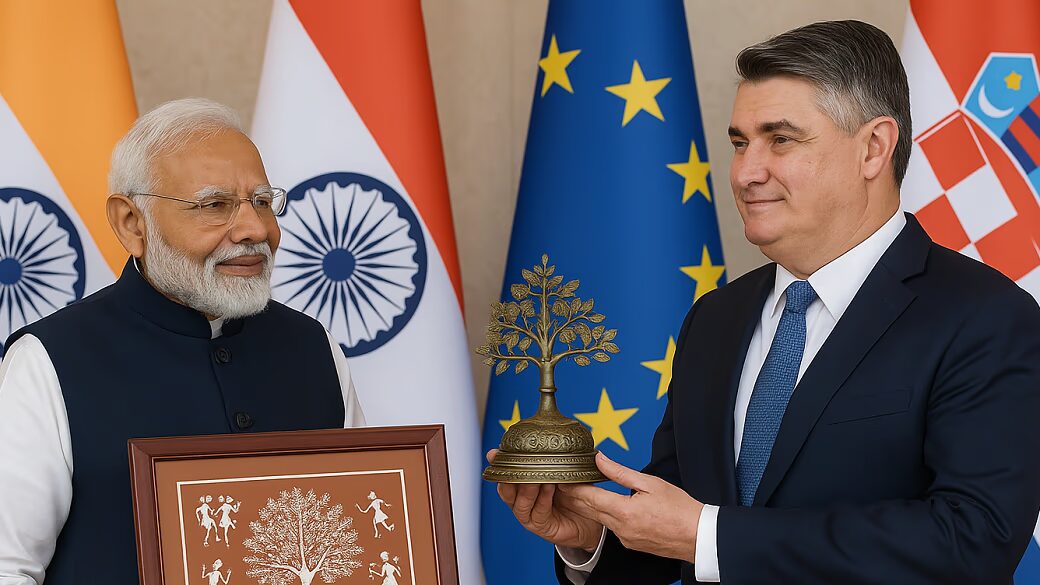
On June 18, 2025, Narendra Modi became the first Indian PM to visit Croatia. To the untrained eye, this might have looked like just another pit stop on a European tour. But for those paying closer attention, this was India reaching out—not just to Europe, but to a piece of its own forgotten cultural history.
ALSO READ- QS World University Rankings 2026
A Visit Rooted in Respect, Not Just Strategy-
Modi’s visit came at the tail end of a three-nation diplomatic circuit that included Cyprus and Canada. Croatia, a relatively small European country nestled along the Adriatic Sea, might not be the first name that comes to mind when you think of India’s strategic priorities. But therein lies the charm—and the cleverness—of the visit.
In a world that often views diplomacy through the lens of economic power and military alliances, choosing Croatia sent a different message. It said: We remember our friends, even the quiet ones.
For the Croatian people, it was a welcome surprise. Locals gathered near the government buildings in Zagreb as Modi’s motorcade rolled in. A few waved Indian flags; others simply watched with curiosity. For many, it was their first brush with Indian diplomacy in action. And that curiosity? That’s where the connection begins.
A Brief Historical Tapestry: Croatia, Russia & India-
Croatia and India, though far apart geographically, share a warm and respectful relationship built on history, culture, and mutual understanding. Croatia, nestled in Southeast Europe along the Adriatic Sea, has a rich past shaped by ancient Roman influence, centuries under the Austro-Hungarian Empire, and later as part of Yugoslavia. After gaining independence in 1991, Croatia emerged as a modern European nation, proud of its heritage and committed to democratic values.
India, on the other hand, is a land of deep-rooted traditions and one of the world’s oldest civilisations. After centuries of foreign rule, India became independent in 1947 and has grown into a vibrant democracy and global power. The two countries officially established diplomatic ties in 1992, and since then, their friendship has grown steadily. From cultural exchanges and tourism to trade and education, India and Croatia have found common ground. There’s a genuine warmth between the people and a shared vision for peaceful cooperation and progress.

When the Past Walks Into the Present-
Among the many formalities, one stood out—not for its political significance, but for its sheer elegance. Modi brought with him a reprint of the first-ever printed Sanskrit grammar, originally written in Latin by Father Johann Ernst Hanxleden Vezdin, a Croatian missionary from the 18th century.
A Croatian scholar, over two centuries ago, studied Sanskrit so deeply that he wrote a grammar guide—in Latin—so the Western world could begin to understand it. This book, published in 1790, was long forgotten by the public, tucked away in the footnotes of history.
But on that June day, Modi didn’t just hand over a book. He handed Croatia a mirror—one that reflected their role in the intellectual bridge between East and West.
It was subtle. It was profound. And for those who knew the story, it brought goosebumps.
Behind the Headlines: A Cultural Undercurrent-
Media outlets covered the visit with the usual bullet points: trade talks, tourism potential, and bilateral cooperation. And sure, those are important. Croatia has a strong tourism economy and is keen to tap into the Indian market. India, on the other hand, is always scouting for new partnerships within the EU framework.
But culture was the heartbeat of this visit.
Croatian students at a Zagreb university were given a chance to explore Indian art firsthand, thanks to gifts of Warli tribal paintings and a miniature brass Bodhi tree. The joy on their faces wasn’t staged. It was sincere. For them, India wasn’t just a place on a map anymore. It was a living, breathing culture that had reached out with open arms.
One student said, “We study Latin here, but I never imagined our country had such a deep tie to Sanskrit. This makes me want to learn more.”
That’s the kind of diplomacy that lasts.
A Tale of Three Nations-
Cyprus, Canada, and Croatia. On paper, a curious mix. But together, they represent the three pillars of India’s current diplomatic strategy:
- Heritage and Energy (Cyprus)
- Technology and Trade (Canada)
- Culture and Soft Power (Croatia)
It’s not just smart diplomacy—it’s thoughtful diplomacy. And that thoughtfulness showed even in the smaller details. From the careful selection of gifts to the warm, unhurried conversations with Croatian leaders, this wasn’t a whirlwind visit. It was a meaningful pause.
So What Comes Next?
The agreements signed may not make front-page news. They’re mostly about tourism, educational exchange, and cultural collaboration. But don’t be fooled—these are the kinds of seeds that, when planted right, grow into strong diplomatic trees.
Expect to see more academic partnerships between Indian and Croatian universities.

Final Word-
Modi’s visit to Croatia wasn’t meant to dazzle. It was meant to connect. In a world often obsessed with dominance and deals, it reminded us of something softer, quieter, and maybe more important: that diplomacy isn’t just about agreements. Sometimes, it’s about acknowledgement. And sometimes, the best way to shape the future… is to honour the past.
